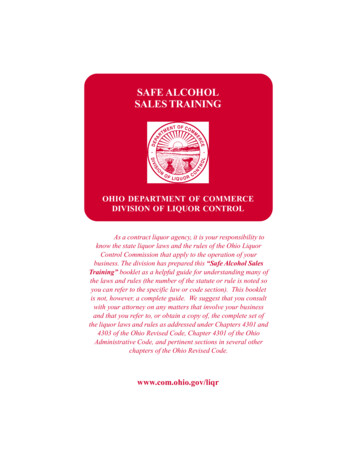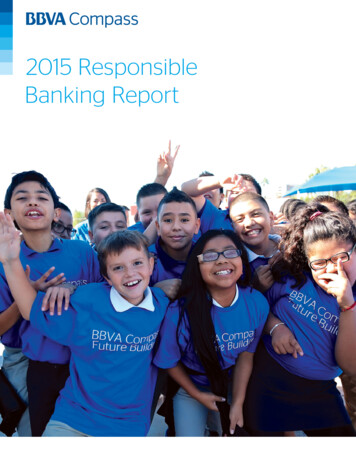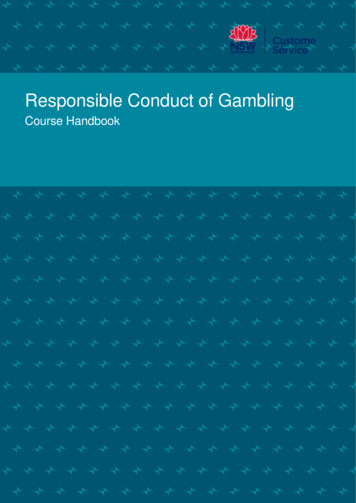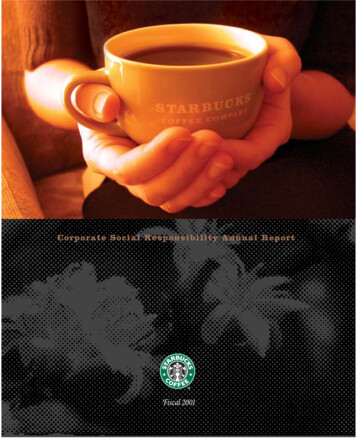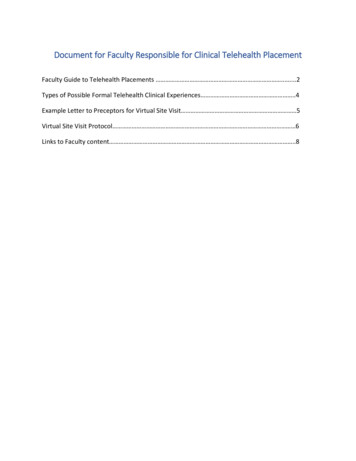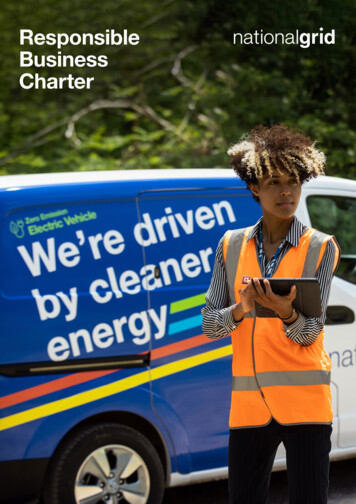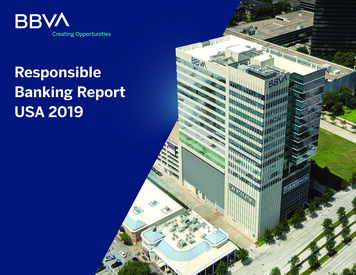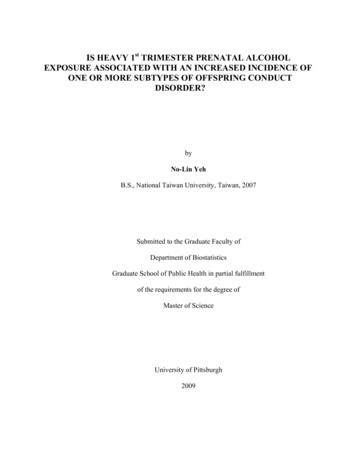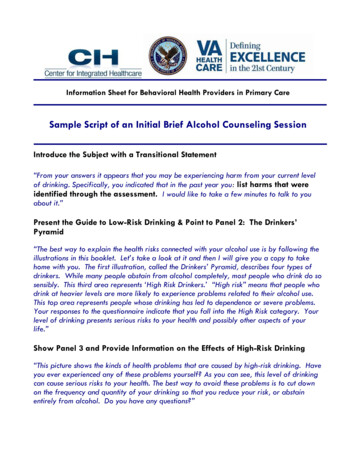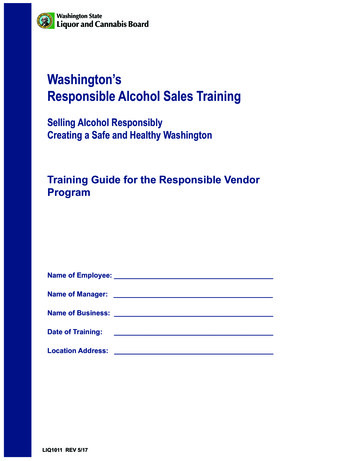
Transcription
Washington’sResponsible Alcohol Sales TrainingSelling Alcohol ResponsiblyCreating a Safe and Healthy WashingtonTraining Guide for the Responsible VendorProgramName of Employee:Name of Manager:Name of Business:Date of Training:Location Address:LIQ1011 REV 5/17
Washington State Liquor and Cannabis BoardResponsible Alcohol Sales Training GuidePage B
Table of ContentsIntroduction. . . pg.2How to Use This Training Guide. . . pg.3What is the Responsible Vendor Program?. . . pg.4Facts about Alcohol. . . pg.4Illegal Alcohol Sale Penalties. . . pg.6Recognizing Alcoholic Products. . . pg.7Checking ID: Making Legal Sales. . . pg.7Refusing Sales to Apparently Intoxicated Individuals. . . pg.163rd Party Sales. . . pg.17Documentation / Recordkeeping. . . pg.18Your Responsibility as a Seller of Alcohol. . . pg.19RVP Quiz. . . pg.20Answer Key. . . pg.23Acknowledgment of Understanding. . . pg.24Washington State Liquor and Cannabis BoardResponsible Alcohol Sales Training GuidePage 1
IntroductionDear Alcohol Sales Employee:On behalf of the Washington State Liquor and Cannabis Board, I would like to thank you forparticipating in the Responsible Alcohol Sales training. As a seller of alcohol products, you play animportant role in creating safe communities by selling alcohol responsibly. Your informed judgment andaction is crucial to preventing illegal sales.By completing this training, you will learn to sell alcohol products responsibly by: Understanding liquor laws and your house polices on alcohol sales Only accepting legal forms of ID for age verification and knowing how to check them Recognizing signs of intoxication Refusing illegal sales Adopting best practicesIn addition to this training, Liquor and Cannabis Board staff is available to answer any questions youmight have. If you require additional help, simply contact your manager or the Responsible VendorProgram using the contact information on the following page.The Liquor and Cannabis Board looks forward to working with you to make Washington a place wherealcohol is sold, served, and consumed responsibly.Sincerely,Rick GarzaWSLCB DirectorWashington State Liquor and Cannabis BoardResponsible Alcohol Sales Training GuidePage 2
How to Use This Training Guide:This training guide is designed to teach employees how to sell alcohol in a way that will prevent salesto minors and intoxicated persons. By following these specific practices employees can ensure liquoris sold responsibly. Employees should study this guide with the help of management to ensure theyunderstand their responsibility in regards to the sale of alcohol. Management must ensure employeesdemonstrate mastery of the material before certifying their completion of the training.Once successfully completed, this training meets the employee training requirement for the RVP.Before starting the training, you will need:1. A copy of your House Policy2. A copy of the Responsible Alcohol Sales Training Guide for you to use and keepYou can also view the Responsible Liquor Sales and Last Call video, both of which are available onlineat the WSLCB website. Responsible Liquor Sales eo Last Call video:lcb.wa.gov/licensing/last-call-videoYou may request hard copies of the videos by contacting us at RVP@lcb.wa.gov.There are periodic quizzes throughout the training guide for you to answer. The answers to thesequizzes can be found on page 21.For any questions, assistance or additional training materials, please contact the Liquor and CannabisBoard, Responsible Vendor Program.Responsible Vendor Program / Mandatory Alcohol Server Training ProgramWashington State Liquor and Cannabis Board3000 Pacific Avenue/PO Box 43098Olympia WA 98504-3098Washington State Liquor and Cannabis BoardWebsite: lcb.wa.govTelephone: 360-664-1727/1728Email to RVP@lcb.wa.govResponsible Alcohol Sales Training GuidePage 3
What is the Responsible Vendor ProgramWhat is the Responsible Vendor Program (RVP)The RVP is designed to help retailers adopt and enforce specific practices to ensure alcohol is soldresponsibly and prevents its illegal use and abuse. Participating retailers who meet and maintain theprogram requirements may qualify for a reduced sanction* in the event they conduct an illegal sale.*Spirits Retailer: Any spirits retailer participating in the RVP who meets and maintains all of the programrequirements is eligible to receive the standard penalty instead of the double penalty (50% reduction)once in twelve month period for an illegal sale.*Beer and Wine Retailer: Any beer and wine retailer participating in the RVP who meets and maintainsall of the program requirements is eligible to take a deferment for a first time violation once in a 24month period. If there are no further public safety violations within the 24 month period, the violation isdismissed.To become a certified RVP member retailers must meet and maintain the following requirements:Spirits Retailer: Establish and enforce a house policy for alcohol handling Post signs deterring the illegal purchase of alcohol Train employees prior to selling alcohol. Provide refresher training at least once a year Keep training records Post RVP member certificate for viewing Have no public safety violations in the last two yearsBeer and Wine Retailer: Establish and enforce a house policy for alcohol handling Post signs deterring the illegal purchase of alcohol Train employees at least once a year Maintain a responsible alcohol retail management policy Keep training records Post RVP member certificate for viewing Have no public safety violations in the last two yearsFacts About AlcoholAlcohol is a factor in an average of approximately 4,700 deaths among underage youths in the UnitedStates every year.*Washington State Liquor and Cannabis BoardResponsible Alcohol Sales Training GuidePage 4
Underage drinking contributes to a wide range of costly health and social problems, including motorvehicle crashes, suicides, homicides, assaults, risky sexual activity, unintentional injuries, brainimpairment, academic problems, and alcohol and drug poisoning.*Underage drinking cost the citizens of Washington State 1.4 billion in 2007 alone. (Centers forDisease Control and Prevention)500,000 college students between the ages of 18 and 24 are unintentionally injured under the influenceof alcohol. (Hingson et.al., 2009)Drinking too much, including binge drinking, cost 746 per person, or 1.90 a drink, in the US in 2006.These costs include health care expenses, crime, and lost productivity. (Centers for Disease Controland Prevention)From 2008 through 2012, a total of 1,047 fatal crashes involving an impaired driver occurred onWashington roadways. These crashes resulted in 1,160 impaired-driver-involved deaths, an averageof 232 per year, or 49.0 percent of all traffic fatalities in this five-year period. Among these deaths 40percent involved an alcohol-impaired driver (2012 Washington State Annual Collision Summary)*Report to Congress on the Prevention and Reduction of Underage Drinking, U.S. Department ofHealth and Human Services, Substance Abuse and Mental Health Services Administration, May 2011.Alcohol is not like other productsAlcohol is a popular recreational product for many consumers, but it is also a drug that is associatedwith a host of harmful effects when used excessively or improperly. Alcohol sales must be treateddifferently than most other products.Due to the high risk of abuse it is important for your business to monitor alcohol sales closely. You needto be aware of its impact when used improperly and be vigilant in not allowing minors or apparentlyintoxicated people to purchase it.Your liabilityIt is your responsibility to know the laws regulating the safe sale of alcohol. Ignorance of the law is not avalid defense and you will be subject to legal penalties if you conduct an illegal sale.Illegal alcohol sales can result in fines, a criminal record, loss of employment, cancellation of theestablishment’s liquor license, and a possible civil lawsuit.Ultimately your employer is responsible for your actions and may impose their own penalties.According to your house policy, what consequences could you face if you make an illegal sale?Washington State Liquor and Cannabis BoardResponsible Alcohol Sales Training GuidePage 5
Illegal Alcohol Sales PenaltiesIt is illegal to sell alcohol to anyone less than 21 years of age and/or anyone who appears to beintoxicated. If you do so, you could face serious penalties. If you sell alcohol to a minor, you could receive a criminal citation and you may have to appear incourt. You could be fined up to 5,000 and serve up to one year in jail. If you sell alcohol to an apparently intoxicated person, you could receive a criminal citation andyou may have to appear in court. You could be fined and face jail time. You could lose your job. Since you employer is ultimately responsible, they could suspend or fireyou for an illegal sales violation. You could be sued. If someone dies or gets hurt as a result of your illegal sale, you could be suedfor lost earnings, pain and suffering, medical expenses, etc. Your employer could be in trouble. The business could face fines or have its liquor licensesuspended. If the business receives four violations within two years, it could lose its liquorlicense permanently.You can only sell alcohol to a person who is 21 years of age or older and who does not show obvioussigns of intoxication. It is illegal for a customer showing signs of intoxication to possess, consume orpurchase liquor.Quiz #1:1. Can you sell a bottle of wine to a customer showing some signs of intoxication but who isn’tdriving? Yes No2. A group of young people come into the store but only one person is purchasing the alcoholbecause only that one person is over 21 years old. Should you sell alcohol to this person? Yes No3. You sold alcohol to a minor because a coworker vouched for the minor’s age. Who is liablefor the violation? Seller (You) Co-worker4. A person who appears to be in their 30’s has forgotten their identification but still wants topurchase a six pack of beer. Would you sell them the beer without checking their ID? Yes NoWashington State Liquor and Cannabis BoardResponsible Alcohol Sales Training GuidePage 6
Recognizing Alcoholic ProductsThe ever-changing market can make it difficult to distinguish alcoholic products from non-alcoholicproducts. It is important that you clearly understand which products contain alcohol to ensure you checkID. Some of the products which may cause confusion include: Some flavored malt beverages because they can look like energy drinks or sodas. Alcoholic beverages that come in pouches in a variety of sizes, some of which look very similarto children’s juice drinks. Frozen products containing alcohol that look similar to popsicles. Pocket shots in small containers because they don’t look like a typical productcontaining alcohol.Did you know the sale of pre-mixed alcoholic energy drinks was banned in Washington State in 2010?Combining alcohol and stimulants such as caffeine, guarana, and taurine may increase the risk alcoholrelated injury.Can you identify the products containing alcohol in your store? Please fill out answers onthe lines below. If you need assistance, check with your manager.List the products containing alcohol at your business:Does your point of sale system alert you when scanning products that require a minimum age forpurchase?If your system does not, what is your method of identifying products containing alcohol?Checking ID: Making Legal SalesChecking identification is an important part of ensuring legal alcohol sales. Liquor laws do not requireyou to check ID but if you sell alcohol to a minor, you will be violating the law. The only way to ensurethe purchaser is of the legal age is to check their ID.“Looks under 30? Check ID”Washington State Liquor and Cannabis BoardResponsible Alcohol Sales Training GuidePage 7
You may choose not to accept all IDs allowed under the law, including vertical IDs. If youdon’t accept them all, have your employee circle the ones accepted at your premises orwrite them on the line below.Acceptable forms of identification A driver’s license, ID card, or instruction permit issued by any U.S. state, Canadian province, a USterritory or the District of Columbia A U.S. military ID An official passport A Merchant Marine ID A Washington State Tribal Enrollment cardA valid ID must show: Date of birth Signature (except U.S. military ID) Photo Expiration date (except Tribal Enrollment cards)Your store might not accept all ID’s allowed under the law, including vertical ID’s. Pleasecheck with your manager for a complete list.What forms of ID does your store accept?How to check ID1. Ask for identification.2. Have the customer hand you the ID. Do not accept or handle a customer’s wallet.3. Check the expiration date. Do not accept expired ID.4. Check the date of birth. For vertical ID’s, check the information to the left of the photo to make surethe customer has turned 21.5. Verify the photo matches the customer.6. Verify the ID’s unique features.T-L-A methodUsing the T-L-A (Touch, Look, Ask) method helps you to verify that the ID the customer is using islegitimate and not fake or alteredWashington State Liquor and Cannabis BoardResponsible Alcohol Sales Training GuidePage 8
TOUCHHold ID and feel for: Raised edges around photo Cuts, slits, or pin holes Bumpy surfaces Peeling lamination or uneven corners Irregular lamination Thickness and quality of IDLOOKLook. Really look, don’t just glance at the ID Check expiration date first andreject expired ID Reject “Void” ID Check birthdates Check photo: does it look like the person? Compare consistency of printing: Look for letters andnumbers that don’t match or line up Turn ID over and check info on backASKIf the ID is still in question, ask for second piece of ID. People with fake ID rarely carry back-upID. Quiz the person: What’s your zip code? What year did you graduate high school? What’s your address? How do you spell your middle name? How old are you? Ask person to sign their name and compare it tosignature on IDVerifying an ID’s unique featuresMany ID’s have special features that make it hard to duplicate or copy. In February 2017 theWashington Department of Licensing introduced new designs for the driver’s license and ID card.Identification bearing the old design is valid until it expires. The Washington State driver’s license andID have the following unique features:New Washington ID/driver’s license:1. Ghost portrait (faint photo) at bottom right of card2. 100 rule: the first two numerals in the driver’s license# the last two digits of the date of birth should addup to 100. (ex: 27 73 100)3. Printed data overlapping the ghost image4. Foil printed tree5. Fine line pattern on the front of the identification6. Washington hologram and state seal repeats across the front (state seal also on back) in ultravioletink that will illuminate under ultraviolet light. Not shown on exampleWashington State Liquor and Cannabis BoardResponsible Alcohol Sales Training GuidePage 9
Old Washington ID/driver’s license(valid until expiration date):1. Ghost portrait (faint photo) at bottom right of card2. WA USA in the heading3. Printed data overlapping the ghost image4. 100 rule: the first two numerals in the driver’s license# the last two digits of the date of birth should addup to 100. (ex: 14 86 100)5. Void appears if laminate is altered (do not accept this ID)New vertical Washington ID/driver’s license:1. Ghost portrait (faint photo) at the right of card2. 100 rule: the first two numerals in the driver’s license# the last two digits of the date of birth should addup to 100. (ex: 01 99 100)3. “Age 18/21 on” at the bottom of the ghost image4. Foil printed tree5. Fine line pattern on the front of the identification6. Washington hologram and state seal repeats across the front(state seal also on back) in ultraviolet ink that will illuminateunder ultraviolet light. Not shown on exampleVertical Washington ID/driver’s license(valid until expiration date):1. Ghost portrait (faint photo) at bottom right of card2. WA USA in the heading3. Age 18/21 ON4. 100 rule: the first two numerals in the driver’slicense # the last two digits of the date of birthshould add up to 100. (ex: 06 94 100)5. Void appears if laminate is altered (do not accept this ID)Not shown on exampleWashington State Liquor and Cannabis BoardResponsible Alcohol Sales Training GuidePage 10
New temporary license:The new temporary license is a letter-size (8 ½” X 11”) sheet of paper and will not include a photoand signature, unless it’s a Commercial Driver License. The new temporary license by itself is notacceptable to purchase alcohol, however, if combined with an expired valid ID with a photograph, it maybe accepted.WASHITR238MGWASHINGTON, TEST RECORDThis is your temporary document. Carry this with you until you receive your new one in the mail.Your new card will show the last photo we took. If you don’t receive your document in 45 days, please call us(360) 902-3900 or email drivers@dol.wa.gov.This Temporary Document Expires 7/16/2017This document is intended to be used for driving purposes only. It is not valid for identificationpurposes unless accompanied by another piece of identification, like a recently expired driver license.NAMEBIRTH DATEGENDERHGTWGTEYESRESIDENCE ADDRESSDOCUMENT TYPELICENSE #CONTROL #ISSUE DATEEXPIRATION DATERESTRICTIONSENDORSEMENTSCLASSORGAN DONORVETERANYour license will be mailed to: PERSONAL INFORMATION WASHINGTON, TEST RECORD07/07/1977F5'-06"150HAZ123 SAMPLE LANE SEOLYMPIA, WA, 98504-0001 LICENSE INFORMATION DRIVER 23NONENONENONEYESNO MAILING ADDRESS 123 SAMPLE LANE SEOLYMPIA, WA, 98504-0001Washington State Liquor and Cannabis BoardResponsible Alcohol Sales Training GuidePage 11
Vertical ID’sIt is up to the licensee whether or not to accept vertical IDs.Does your business accept vertical ID’s?Be alert when checking a vertical ID. The customer was issued the ID when they were under 21 yearsof age and could look different due to aging. Check the unique features listed on the previous page,along with the “Age 21 ON.” next to the photo to verify the customer is 21 years of age or older.If the person is not old enough, stop, refuse the sale and follow company policy.Appearances can be deceiving. Certain features or behaviors may make it hard for you to judge acustomer’s age: Facial hair Nervous behavior Makeup Lack of eye contact Clothing Change of hair style/colorHole punched IDWhat do you do if you see a hole-punched ID?A punched driver’s license that has not expired and has not been punched through the picture,signature, date of birth or expiration date is an acceptable form of ID when purchasing alcohol. Checkyour house policy to ensure you are allowed to accept this ID.Circle the acceptable forms of ID at your business:Oregon driver’s licenseUS Navy IDCanadian IDHole Punched IDAlaska driver’s licenseKorean passportInternational driver’slicenseStudent IDDept. of Corrections IDCredit card w/pictureBirth certificateWashington State Liquor and Cannabis BoardResponsible Alcohol Sales Training GuidePage 12
ID Checking ExerciseExamine the following identifications and answer the questionsQuiz #2:Quiz #3:1. What is the date of issue?1. What is the date of issue?2. What is the date of birth?2. What is the date of birth?3. What is the expiration date?3. What is the expiration date?4. What numbers make up the 100 rule?4. What numbers make up the 100 rule?5. Identify (at least) three security features5. Identify (at least) three security featuresQuiz #4:1. What is the date of issue?2. What is the date of birth?3. What is the expiration date?4. What numbers make up the 100 rule?5. Identify (at least) thre
demonstrate mastery of the material before certifying their completion of the training. Once successfully completed, this training meets the employee training requirement for the RVP. Before starting the training, you will need: 1. A copy of your House Policy 2. A copy of the Responsible Alco
